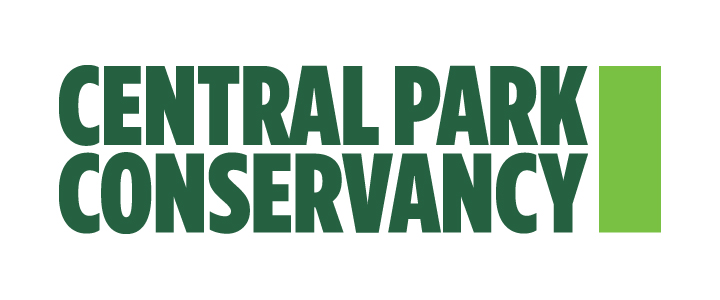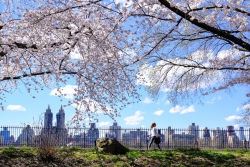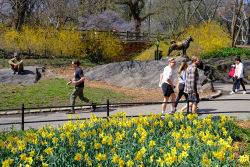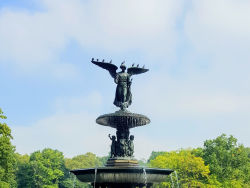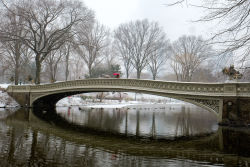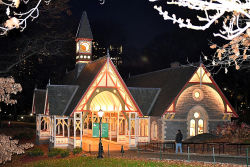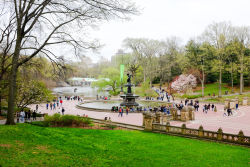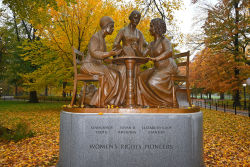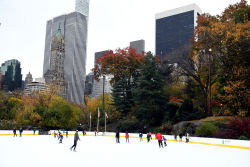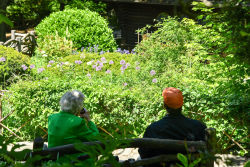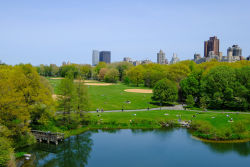Central Park
The Daily Plant : Thursday, February 23, 2006
HOW EDITORS INSERTED PARKS INTO NEW YORK CITY
A recent informal survey of Parkies in the Arsenal asked, "Who were the most important people in Parks history?" The names most commonly given (in order of frequency) were Robert Moses, Frederick Law Olmsted, Henry Stern, and Calvert Vaux. Not one person named Williams Cullen Bryant, Walt Whitman, or John Mullaly—the key forces in the creation of Central Park, Prospect Park, and the entire Bronx park system.
In 1844, 14 years before Olmsted and Vaux handed in their Greensward plan, Evening Post editor William Cullen Bryant expounded on the need for a central park in New York City. Soon after, Horticulturalist editor Andrew Jackson Downing echoed these sentiments. Following that lead, Walt Whitman, editor of the then-independent City of Brooklyn’s Daily Eagle, began advocating for his city to build Prospect Park. So, although it’s the fruit of Olmsted and Vaux’s visionary work that we see, we must remember that editors planted those parks’ seeds in the City’s soil.
The Bronx, boasts three of New York City’s ten largest parks: Pelham Bay Park is biggest with more than 2,700 acres, Van Cortlandt comes in number four at 1,146 acres, and Bronx Park is number eight with 718 acres. All of these acquisitions—along with Claremont, Crotona, and St. Mary’s Parks—came at the hands of John Mullaly, a career newspaper man who worked in a series of posts at several publications before helping to found the New York Park Association in 1881.
Each of these eminent editors have New York City parks named in their honor; additionally, there are over a dozen parks named for editors whose words impacted the history of their local communities—or, in some cases, the entire nation. From the simple stone relief portrait inserted into the wall of Central Park that honors editor Arthur Brisbane of The New York Sun to Manhattan’s two large statues honoring Horace Greeley, the founding editor of the New York Tribune, parks around the city pay tribute to historic editors.
Starting in 1831, William Lloyd Garrison published and edited The Liberator, a newspaper through which, for 35 years, he denounced the practice of slavery. His efforts earned him equal amounts of praise, scorn, and respect. Southerners’ reaction to The Liberator was strong. The South Carolina Vigilance Committee offered a $1,500 reward for the arrest of anyone distributing the publication, while the Georgia House of Representatives offered a $5,000 reward for Garrison’s capture and trial. He is honored with a playground in the Bronx.
Manuel de Dios Unanue Triangle Park in Queens honors the memory of another brave newspaper editor who, though he was born in Cuba more than 140 years after Garrison, shared the belief that exposing the truth is a prime responsibility of journalism. Unanue edited El Diario-La Prensa and relentlessly covered the Colombian narcotics trade in Queens. His vociferous efforts to publicize these illegal actions cost him his life; he was shot by a contract killer working for the drug cartel that he exposed.
Although many people whose careers culminated as editors had a great impact on history, there are also great figures who had their start in editing. Roy Wilkins, for whom a park and recreation center in Queens are named, began his career in journalism. From 1934 to 1949, he served as editor of The Crisis, a magazine founded by W.E.B. Dubois. Wilkins rose to the position of NAACP president, where he worked tirelessly to promote voter rights legislation, fair housing laws, and equity in wages.
Even Parks’ favorite poet Joyce Kilmer was once a dictionary editor. And although he specified that "fools" make poems, he never mentioned who edits them.
-written by John Mattera
QUOTATION FOR THE DAY
"An ant on the move does more than a dozing ox."
Lao Tzu
(600-531 B.C.)
Check out your park's Vital Signs
Clean & Safe
Green & Resilient
Empowered & Engaged Users
Share your feedback or learn more about how this park is part of a
Vital Park System

Know Before You Go
Anticipated Completion: Spring 2024
Anticipated Completion: Spring 2025

Contacts
Central Park Information: (212) 310-6600
Central Park Information (for the Hearing Impaired): (800) 281-5722
Belvedere Castle, The Henry Luce Nature Observatory: (212) 772-0210
The Charles A. Dana Discovery Center: (212) 860-1370
The Dairy Visitor Center and Gift Shop: (212) 794-6564
North Meadow Recreation Center: (212) 348-4867
Loeb Boathouse (Bike rentals, boat rentals & gondolas): (212) 517-2233
Carousel: (212) 879-0244
Fishing at Harlem Meer (Catch & Release): (212) 860-1370
Harlem Meer Performance Festival: (212) 860-1370
Horseback Riding - Claremont Stables: (212) 724-5100
Metropolitan Opera (Performances on the Great Lawn): (212) 362-6000
New York Philharmonic (Performances on the Great Lawn): (212) 875-5709
Shakespeare in the Park - The Public Theater at the Delacorte Theater: (212) 539-8655
Central Park SummerStage: (212) 360-2777
Swedish Cottage Marionette Theater: (212) 988-9093
Tennis: (212) 280-0205
Weddings, Ceremonies and Photography at the Conservatory Garden: (212) 360-2766
Wildlife Center & Tisch Children's Zoo: (212) 439-6500

